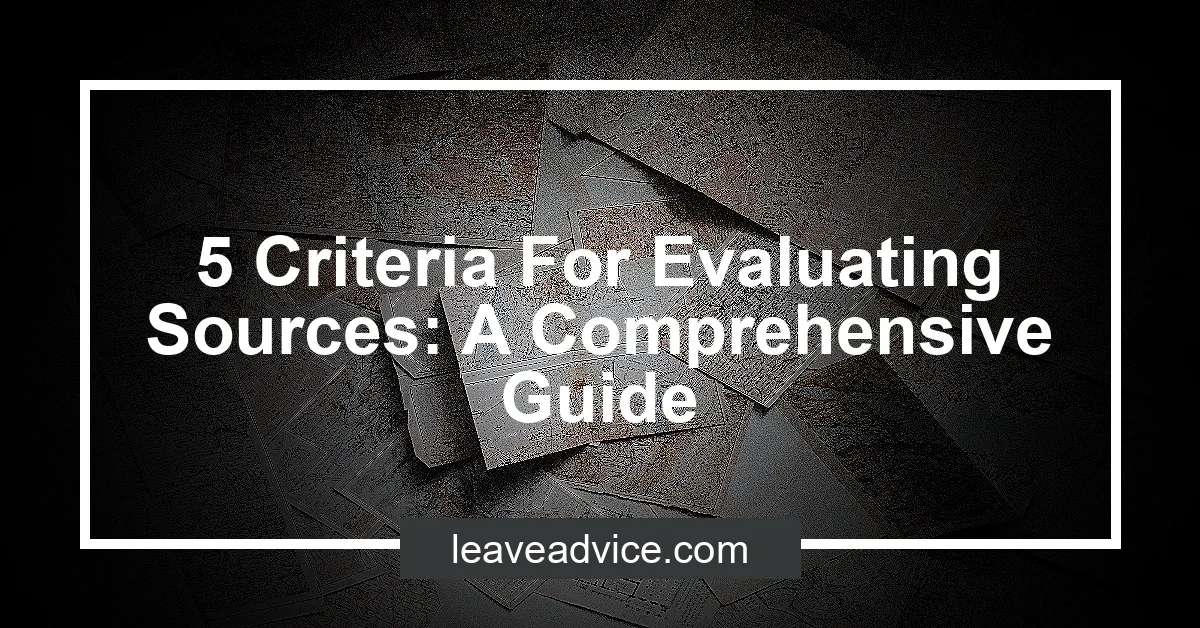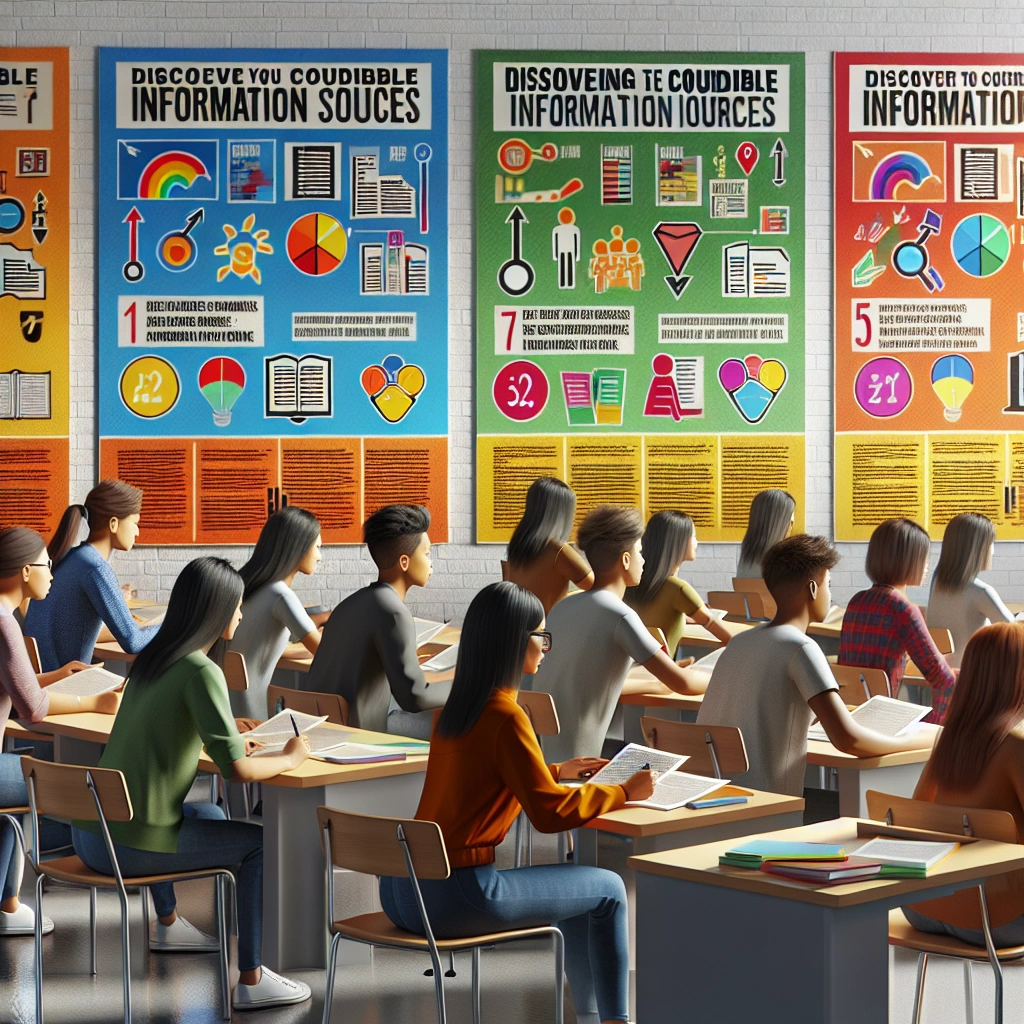5 Criteria For Evaluating Sources: A Comprehensive Guide


Evaluating sources is important for ensuring the validity and reliability of information.
There are 5 criteria for evaluating sources: Authority, Accuracy, Objectivity, Currency, and Coverage.
Critical thinking is essential when evaluating sources to avoid misinformation and make informed decisions.
Check out this Youtube video: Want to know the 5 criteria for evaluating sources? Watch this informative video to make sure you’re getting reliable information!
Authority
Definition of authority in the context of evaluating sources
Authority in the context of evaluating sources refers to the credibility and expertise of the author or organization providing the information. It involves assessing whether the author has the knowledge and qualifications to speak on the subject matter.
Importance of considering the author’s expertise and credentials
Considering the author’s expertise and credentials is crucial because it determines the reliability of the information. Evaluating the author’s background helps in gauging the depth of knowledge and experience brought into the content, thereby ensuring that the information is accurate and trustworthy.
Examples of authoritative sources
- Academic Journals: Well-researched articles written by subject matter experts and reviewed by peers.
- Government Publications: Reports, studies, and data released by government institutions, providing reliable information.
- Industry Expert Publications: Publications authored by recognized professionals within specific industries, offering specialized insights and information.
| Type of Source | Description |
|---|---|
| Academic Journals | Well-researched articles by subject experts, offering in-depth knowledge. |
| Government Reports | Data and studies released by government bodies, presenting reliable information. |
| Industry Publications | Insights authored by recognized professionals within specific fields, providing specialized information. |
Accuracy
Definition of accuracy in the context of evaluating sources
When we talk about accuracy in evaluating sources, we’re really emphasizing the correctness, truthfulness, and overall excellence and quality of the information. It’s all about ensuring that the information provided is completely correct and verifiable.
Importance of fact-checking and verifying information
Fact-checking and verifying information are crucial because they help in confirming the reliability and truthfulness of the content we are exposed to. It’s like having a truth detector that ensures that what we are reading, hearing, or seeing is based on actual facts and not just someone’s opinion or fabrication.
How to identify inaccurate sources
Identifying inaccurate sources involves looking for clues that indicate unreliability such as biased content, outdated information, or clear inaccuracies. It’s like being a detective and investigating the credibility of the source by checking the domain name, author, and facts presented.
Fact-checking tools and resources
Fact-checking tools and resources can make our lives easier by providing us with the means to verify information quickly and effectively. These tools can include online fact-checking websites, databases, and browser extensions that help us assess the accuracy and credibility of the sources we encounter.
Objectivity
Definition of objectivity in the context of evaluating sources
Objectivity in the context of evaluating sources refers to the ability to present information without bias or partiality. It involves providing a balanced perspective, considering multiple viewpoints, and avoiding the influence of personal beliefs or opinions.
An objective source aims to offer information that is fair, impartial, and free from subjective influences.
Importance of considering bias and perspective
Considering bias and perspective is crucial when evaluating sources as it helps in discerning the reliability and credibility of information. Bias can significantly impact the accuracy of content, leading to skewed viewpoints and misleading conclusions.
By being mindful of bias and perspective, individuals can make informed decisions about the trustworthiness of the information they encounter, ensuring that they rely on sources that present a well-rounded and impartial view.
Examples of biased sources and how to identify them
Biased sources can manifest through persuasive language, selective use of facts, or the omission of alternative viewpoints. For instance, an article or study may exhibit bias by cherry-picking data that supports a specific viewpoint while ignoring contradictory evidence.
Identifying biased sources involves recognizing language loaded with emotion or judgment, as well as assessing the absence of balanced representation of differing perspectives.
Importance of seeking multiple perspectives
Seeking multiple perspectives is integral in gaining a comprehensive understanding of a topic. By engaging with diverse viewpoints, individuals can broaden their knowledge, challenge their own biases, and arrive at well-informed conclusions.
Consulting varied sources and viewpoints also helps in mitigating the impact of bias, as exposure to a range of opinions facilitates critical thinking and enhances the overall reliability of the information accessed.
Currency
Definition of currency in the context of evaluating sources
Currency in the context of evaluating sources refers to the timeliness or the freshness of the information. It is about determining whether the information provided is current enough to be relevant to the topic or research question.
Importance of considering the timeliness of information
Considering the timeliness of information is crucial because it ensures that the sources used are up-to-date and reflect the latest developments or understanding of the subject matter. Outdated information can lead to misleading conclusions and inaccuracies in research findings.
Examples of outdated or irrelevant sources
An example of an outdated source could be a research study conducted 10 years ago that doesn’t reflect current trends or advancements in the field. Another example is a website with no “Last Updated Date” or one that has not been updated in the past year, indicating potential irrelevance or outdated information.
Relevance
Definition of relevance in the context of evaluating sources:
Relevance in the context of evaluating sources refers to the significance and pertinence of the information in addressing specific research needs. It involves determining whether the sourced information directly relates to the research question and if it contributes meaningfully to the desired outcome.
Importance of considering the appropriateness of information for a specific purpose:
Considering the appropriateness of information for a specific purpose is crucial in ensuring the accuracy and effectiveness of the research. It helps in avoiding irrelevant data or biased sources, ultimately leading to informed and credible decisions based on valid information tailored to the specific research goals.
Examples of irrelevant sources:
1. Fictional Novels: While enjoyable, fictional novels typically do not provide factual data relevant to academic or research purposes.
2. Personal Blogs: Information from personal blogs might lack credibility and factual evidence, making it unsuitable for academic or professional research.
3. Social Media Posts: While valuable for social interaction, social media posts often lack credibility and authoritative sourcing for scholarly research.
Evaluating Online Sources
Considerations for evaluating online sources
When evaluating online sources, it is crucial to consider the authority, accuracy, objectivity, currency, coverage, and reliability. Without these considerations, one might fall victim to misleading or false information.
Importance of understanding internet domain types
Understanding internet domain types is vital as it can help in gauging the credibility of a source. Different domain types may indicate the purpose and reliability of a website.
For example, a “.gov” domain signifies a government website, which is more likely to provide accurate and trustworthy information.
How to identify credible online sources
Credible online sources can be identified by checking for expert authors, trustworthy publishers, citations, and the absence of bias. Additionally, reliable sources are typically backed up with evidence and recognized by experts in the relevant domain.
Examples of unreliable online sources
Unreliable online sources may include anonymous blogs, unverified social media posts, biased websites, and sources lacking citations or evidence. These sources often provide misleading information and should be approached with caution.
Balancing Quantity and Quality
Importance of balancing the quantity and quality of sources
Balancing quantity and quality of sources is crucial for obtaining reliable and comprehensive information. It ensures that decisions and conclusions are based on a broad range of data while maintaining high accuracy and credibility.
Quantity and quality work hand in hand to provide a well-rounded understanding, preventing biases and oversights.
How to prioritize quality over quantity
Prioritizing quality over quantity involves meticulous scrutiny and assessment of sources. It requires a discerning eye to recognize reputable and authoritative content, even if it means having fewer sources.
Emphasizing quality involves considering the expertise, credibility, and reliability of the sources, aiming for depth rather than breadth.
Examples of instances where quality should be prioritized
Quality should be prioritized when making critical decisions, conducting in-depth research, or addressing complex issues. For instance, in medical research, the precision and accuracy of sources are paramount to ensure the safety and efficacy of treatments.
Similarly, in legal matters, relying on high-quality sources is essential to uphold justice and fairness.
Importance of cross-referencing information from multiple sources
Cross-referencing information from multiple sources is vital in confirming accuracy and mitigating biases. It validates the reliability and credibility of data, enhancing the overall integrity and trustworthiness of the conclusions drawn.
By corroborating information from various sources, discrepancies and inaccuracies can be identified and rectified.
| Criteria | Importance |
|---|---|
| Accuracy | Ensures factual correctness |
| Credibility | Establishes reliability |
| Relevance | Aligns with the research objectives |
| Timeliness | Reflects current information |
The table above outlines the key criteria for evaluating sources, emphasizing the importance of accuracy, credibility, relevance, and timeliness.
Achieving the right balance between quantity and quality of sources is essential for making informed decisions and drawing reliable conclusions. Prioritizing quality, cross-referencing information, and ensuring adherence to specific criteria remain pivotal in achieving this delicate equilibrium.
The Role of Peer Review
Definition of peer review and its importance in evaluating sources
Peer review is a process in which experts in a particular field evaluate the quality and validity of scholarly articles before they are published. It serves as a quality control measure to ensure that only credible and reliable research is made available to the public.
Peer-reviewed sources are crucial in evaluating sources as they undergo rigorous scrutiny by professionals, making them more trustworthy and authoritative than non-peer-reviewed materials.
Importance of seeking peer-reviewed sources
Seeking peer-reviewed sources is crucial as it ensures the accuracy and credibility of the information being used for research or academic purposes. These sources have been evaluated by experts in the field, reducing the risk of misinformation and biased content.
By relying on peer-reviewed sources, individuals can confidently use the information for academic papers, professional research, and decision-making, knowing that it has been thoroughly vetted for quality and accuracy.
The impact of peer review on source credibility
The impact of peer review on source credibility is significant as it enhances the reliability and trustworthiness of the content. Articles that have undergone rigorous peer review are considered to have the highest level of academic credibility, making them highly respected within the scholarly community.
This process contributes to the overall credibility of the sources, ensuring that the information presented is of high quality, accurate, and free from potential biases. Peer review elevates the standard of sources, establishing them as reputable and credible references in academic and professional contexts.
Ethics in Source Evaluation
Importance of ethical considerations when evaluating sources
It is crucial to prioritize ethical considerations when evaluating sources to ensure the credibility and reliability of the information being used. Ethical considerations help in avoiding biased or misleading content, thereby maintaining the integrity of the research or argument.
By upholding ethical standards, the value and impact of the sourced information are enhanced, leading to more persuasive and trustworthy outcomes.
How to navigate ethical dilemmas in source evaluation
Navigating ethical dilemmas in source evaluation involves critically analyzing the information for any potential biases, conflicts of interest, or unethical practices. It requires a careful and objective assessment of the sources, considering factors such as author reputation, publication credibility, and the presence of any vested interests.
By remaining impartial and thorough in the evaluation process, ethical dilemmas can be effectively identified and managed, ensuring the integrity of the sourced information.
Examples of ethical and unethical sourcing practices
Examples of ethical sourcing practices include transparent attribution of sources, respecting copyright and intellectual property rights, and disclosing any potential conflicts of interest. On the other hand, unethical sourcing practices may involve plagiarism, misrepresentation of data, biased reporting, or undisclosed affiliations that influence the information provided.
Adhering to ethical sourcing practices promotes authenticity and integrity, while unethical practices undermine the trustworthiness and credibility of the sourced content.
Teaching Source Evaluation
Importance of teaching source evaluation skills
Teaching source evaluation skills is crucial because it empowers individuals with the ability to discern reliable and trustworthy information from the vast sea of data available on the internet. With the rise of fake news and misinformation, teaching individuals how to critically evaluate sources ensures they make informed decisions and avoid falling victim to misinformation, thereby enhancing their overall digital literacy and critical thinking skills.
Strategies for teaching source evaluation to students and individuals
Implementing real-world scenarios such as fact-checking social media posts, analyzing news articles, and cross-referencing sources can provide practical and engaging experiences for students to develop source evaluation skills. Additionally, integrating interactive workshops, mock debates, and exercises using tools like the CRAAP Test (Currency, Relevance, Authority, Accuracy, and Purpose) can help students and individuals grasp the importance of evaluating sources effectively.
Incorporating source evaluation into educational curricula
Integrating source evaluation into educational curricula can be achieved by designing specialized modules or courses focused on information literacy, critical thinking, and digital citizenship. By incorporating practical exercises, case studies, and real-life examples into the curriculum, educators can foster an environment where students learn to question, evaluate, and verify sources, preparing them to navigate the digital landscape with confidence and discernment.
| Teaching Source Evaluation Strategies |
|---|
| 1. Real-world scenarios for practical experience |
| 2. Interactive workshops and exercises |
| 3. Integration into specialized modules or courses |
By implementing these strategies, educational institutions and educators can equip students and individuals with the essential skills needed to evaluate sources effectively in the digital age, fostering a more informed and discerning society.
Debunking Common Misconceptions
Addressing common misconceptions about evaluating sources
Let’s address a common misconception about evaluating sources — the belief that evaluation is too complicated or takes too long. The fact is that evaluation can be simple and quick.
Utilizing tools like lateral reading, where you verify evidence and contextualize information by comparing sources, can streamline the process and make it more manageable.
Impact of Misinformation
Discussing the impact of misinformation on society
Misinformation has a detrimental impact on society, leading to widespread confusion, distrust, and chaos. When false information spreads, it can lead to people making ill-informed decisions, causing harm to themselves or others.
Additionally, misinformation can create social divisions and amplify existing conflicts, hampering the growth and progress of society.
Examples of the consequences of relying on unreliable sources
The consequences of relying on unreliable sources are severe and far-reaching. During the COVID-19 pandemic, false information circulating on social media led to people consuming harmful substances like bleach as a supposed remedy.
This resulted in life-threatening consequences and highlighted the dangers of relying on unreliable sources for critical information.
Importance of combatting misinformation through source evaluation
Combatting misinformation through source evaluation is crucial for safeguarding the well-being of individuals and society as a whole. By critically evaluating the sources of information, individuals can filter out misinformation and rely on credible sources, thereby making informed decisions and contributing to the betterment of society.
Overcoming Biases in Source Evaluation
Strategies for overcoming personal biases when evaluating sources
Recognize your biases by taking implicit association tests or introspecting to identify your own prejudices. Practice mindfulness to reduce reflexive actions and consider positive examples of people from stereotyped groups.
Slowing down before interacting with specific groups allows time for reflection and consideration. Additionally, exposing yourself to experiences and content from the point of view of stereotyped groups can help in recognizing and addressing biases.
Importance of being aware of personal biases in source evaluation
Being aware of personal biases is crucial for both personal well-being and professional success. It allows individuals to make more objective and informed decisions, leading to a fairer assessment of information and sources.
Understanding personal biases helps in minimizing the impact of prejudices on the evaluation of sources, contributing to improved ethical judgment and decision-making.
How to recognize and address biases in source evaluation
To recognize biases, one should be vigilant for extreme language or one-sided perspectives in historical sources, particularly primary sources. It is essential to critically analyze the language used by the source’s creator to identify potential biases.
Furthermore, understanding bias helps in drawing powerful evaluations about a source. Addressing biases involves considering different perspectives and minimizing the influence of personal prejudices in the evaluation process.
Being aware of biases can aid in critically evaluating sources, arguments, and individual ideas more effectively.
Recommended Amazon Products for Evaluating Online Sources
Here’s a curated list of products that can help you in evaluating online sources with ease. These recommendations are based on authority, accuracy, objectivity, currency, and relevance.
Book Stand for Reading


The book stand is recommended for evaluating online sources as it allows for hands-free reading and referencing while cross-referencing information from multiple sources. The adjustable angle and height make it easy to prioritize quality over quantity when reviewing digital content.
| Pros | Cons |
|---|---|
| Hands-free reading | May not accommodate all book sizes |
| Adjustable angle and height | Not suitable for heavy books |
| Portable and easy to use |
Laptop Stand


A laptop stand is an essential tool for evaluating online sources as it promotes good posture and comfortable reading. It also allows for efficient use of multiple screens, aiding in the consideration of bias and perspective.
| Pros | Cons |
|---|---|
| Promotes good posture | Size may not be adjustable |
| Efficient use of multiple screens | Needs a stable surface |
| Portable and versatile |
Wireless Mouse


A wireless mouse is a convenient tool for evaluating online sources as it allows for easy scrolling through digital content and cross-referencing information from various sources. Its portability and ease of use enhance the consideration of accuracy and objectivity.
| Pros | Cons |
|---|---|
| Enhanced navigation | Needs batteries |
| Portability | May not be suitable for gaming |
| Easy to use |
Blue Light Blocking Glasses


Blue light blocking glasses are essential for evaluating online sources as they protect the eyes from digital eye strain and fatigue, allowing for extended periods of critical thinking and skepticism. By reducing eye strain, they contribute to the consideration of accuracy and relevance.
| Pros | Cons |
|---|---|
| Protects from eye strain | May not fit all face shapes |
| Reduces fatigue | Style may not appeal to everyone |
| Improves focus |
Standing Desk Converter


A standing desk converter is recommended for evaluating online sources as it promotes a healthy and active work environment, fostering critical thinking and skepticism. By allowing for standing or sitting positions, it supports the consideration of currency and relevance.
| Pros | Cons |
|---|---|
| Promotes a healthy work environment | Requires space for setup |
| Adjustable height | May not be suitable for all desks |
| Versatile and ergonomic design |
Top Recommended Product for Evaluating Online Sources
If you’re looking for the best solution for evaluating online sources, we highly recommend the Book Stand for Reading(https://www.amazon.com/s?k=Book+Stand+for+Reading) due to its hands-free reading, adjustable angle and height, as well as its portability and ease of use. Ready to improve your evaluation of online sources? Check out the Book Stand for Reading today for the best results!


Conclusion
The 5 criteria for evaluating sources include authority, accuracy, objectivity, currency, and coverage. It is essential to carefully assess these aspects when considering the credibility of information.
Critical thinking and skepticism play a crucial role in this process, as they enable individuals to question and analyze the sources they encounter.
Furthermore, it is important to emphasize the significance of critical thinking and skepticism in today’s information landscape. With the proliferation of online content, it is easy to be misled by misleading or false information.
By applying the 5 criteria for evaluating sources, individuals can make informed decisions and avoid falling victim to unreliable information. It is crucial to foster a culture of critical thinking and skepticism to navigate the vast amount of information available.
Lastly, I encourage readers to apply the 5 criteria for evaluating sources to all the information they encounter. Whether it is a news article, a social media post, or a scholarly publication, it is important to be discerning about the sources of information.
By consistently evaluating sources using the 5 criteria, individuals can develop a more critical and thoughtful approach to consuming information in today’s digital age.
















